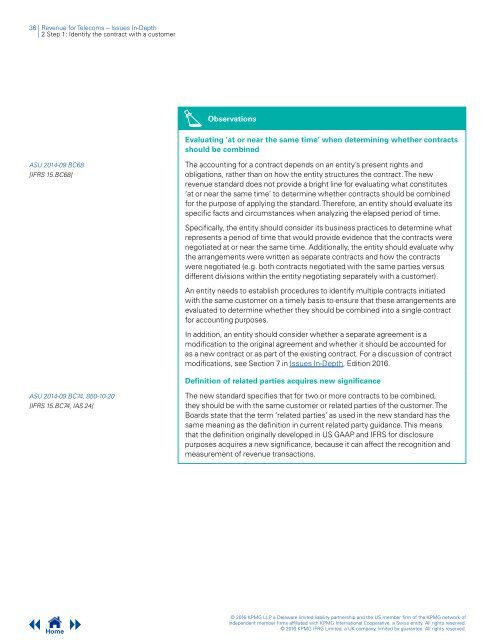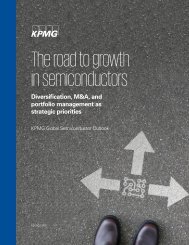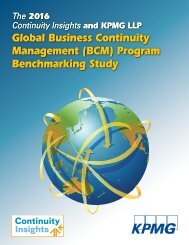Revenue for Telecoms
2cdncba
2cdncba
You also want an ePaper? Increase the reach of your titles
YUMPU automatically turns print PDFs into web optimized ePapers that Google loves.
36 | <strong>Revenue</strong> <strong>for</strong> <strong>Telecoms</strong> – Issues In-Depth<br />
| 2 Step 1: Identify the contract with a customer<br />
Observations<br />
Evaluating ‘at or near the same time’ when determining whether contracts<br />
should be combined<br />
ASU 2014-09.BC68<br />
[IFRS 15.BC68]<br />
The accounting <strong>for</strong> a contract depends on an entity’s present rights and<br />
obligations, rather than on how the entity structures the contract. The new<br />
revenue standard does not provide a bright line <strong>for</strong> evaluating what constitutes<br />
‘at or near the same time’ to determine whether contracts should be combined<br />
<strong>for</strong> the purpose of applying the standard. There<strong>for</strong>e, an entity should evaluate its<br />
specific facts and circumstances when analyzing the elapsed period of time.<br />
Specifically, the entity should consider its business practices to determine what<br />
represents a period of time that would provide evidence that the contracts were<br />
negotiated at or near the same time. Additionally, the entity should evaluate why<br />
the arrangements were written as separate contracts and how the contracts<br />
were negotiated (e.g. both contracts negotiated with the same parties versus<br />
different divisions within the entity negotiating separately with a customer).<br />
An entity needs to establish procedures to identify multiple contracts initiated<br />
with the same customer on a timely basis to ensure that these arrangements are<br />
evaluated to determine whether they should be combined into a single contract<br />
<strong>for</strong> accounting purposes.<br />
In addition, an entity should consider whether a separate agreement is a<br />
modification to the original agreement and whether it should be accounted <strong>for</strong><br />
as a new contract or as part of the existing contract. For a discussion of contract<br />
modifications, see Section 7 in Issues In-Depth, Edition 2016.<br />
Definition of related parties acquires new significance<br />
ASU 2014-09.BC74, 850-10-20<br />
[IFRS 15.BC74, IAS 24]<br />
The new standard specifies that <strong>for</strong> two or more contracts to be combined,<br />
they should be with the same customer or related parties of the customer. The<br />
Boards state that the term ‘related parties’ as used in the new standard has the<br />
same meaning as the definition in current related party guidance. This means<br />
that the definition originally developed in US GAAP and IFRS <strong>for</strong> disclosure<br />
purposes acquires a new significance, because it can affect the recognition and<br />
measurement of revenue transactions.<br />
Home<br />
© 2016 KPMG LLP, a Delaware limited liability partnership and the US member firm of the KPMG network of<br />
independent member firms affiliated with KPMG International Cooperative, a Swiss entity. All rights reserved.<br />
© 2016 KPMG IFRG Limited, a UK company, limited by guarantee. All rights reserved.







